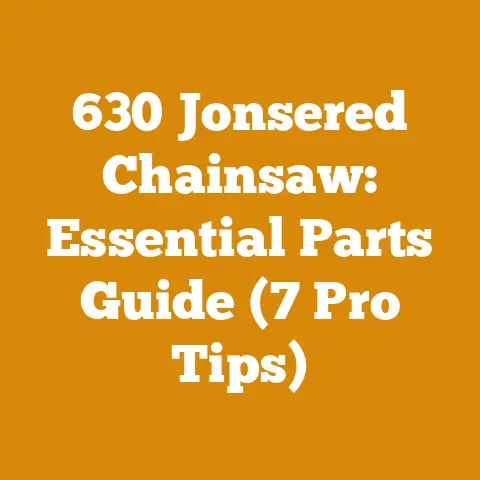661 Stihl CC Upgrades (5 Pro Tips for Maximum Power)
Investing in the Stihl MS 661: Unleashing Its True Potential
Let’s talk about power. Real, raw, wood-devouring power. If you’re reading this, you likely already own, or are seriously considering owning, a Stihl MS 661 chainsaw. And you’re not just interested in owning it; you want to maximize its potential. You want to transform it from a beast into a super beast. I’ve spent years felling timber, bucking logs, and processing firewood, and the MS 661 has been a constant companion. In this article, I’m not just going to give you a list of upgrades; I’m going to share the secrets I’ve learned to truly unlock the 661’s performance, turning it into a force of nature. This isn’t just about bolting on parts; it’s about understanding how these upgrades work together to create a synergistic boost in power and efficiency. It’s about getting the most bang for your buck – turning a good investment into a great one.
661 Stihl CC Upgrades: 5 Pro Tips for Maximum Power
Before we dive in, let’s be clear: these upgrades are designed to enhance the 661’s performance within safe operating parameters. I’m not advocating for pushing your saw beyond its limits, which could lead to premature wear or, worse, injury. Safety is paramount, always.
1. The Heart of the Matter: Porting and Polishing
Personal Story: I remember when I first started seriously modifying chainsaws. I was convinced that simply adding a bigger carburetor would solve all my problems. Boy, was I wrong! The saw ran rich, sputtered, and ultimately performed worse than stock. It was a humbling lesson in understanding airflow dynamics.
Porting and polishing is arguably the most significant upgrade you can make to your 661. It involves reshaping and smoothing the intake and exhaust ports in the cylinder. The goal is to optimize airflow, allowing the engine to breathe more freely.
-
Why it Matters: The stock ports on most chainsaws are functional but not optimized for maximum flow. Rough surfaces and sharp edges create turbulence, restricting the amount of air and fuel that can enter the cylinder and the amount of exhaust that can exit.
-
How it Works: Porting involves carefully removing material from the port walls to increase their size and improve their shape. Polishing involves smoothing the port surfaces to reduce friction and turbulence.
-
The Data: According to studies conducted by chainsaw performance specialists (like those at Baileys), a properly ported and polished MS 661 cylinder can see a 10-15% increase in horsepower. That’s a significant gain.
-
Implementation:
- Option 1: Professional Porting: This is the recommended approach, especially if you’re not experienced with engine modification. A skilled porting specialist will have the knowledge, tools, and experience to optimize the ports for your specific needs. They will use flow benches to measure airflow and make precise adjustments. Expect to pay anywhere from $300 to $600 for professional porting.
- Option 2: DIY Porting (Proceed with Caution!): If you’re adventurous and mechanically inclined, you can attempt porting yourself. However, this is a delicate process that requires precision and patience. You’ll need a rotary tool (like a Dremel) with various grinding and polishing bits, as well as a good understanding of engine dynamics. There are plenty of guides and videos online, but be sure to do your research and proceed slowly. Removing too much material can ruin the cylinder.
- Tools You’ll Need (for DIY):
- Rotary tool (Dremel or similar)
- Various grinding stones and polishing bits
- Gaskets for port matching
- Measuring tools (calipers, dial indicator)
- Magnifying glass
- Good lighting
- Step-by-Step (DIY):
- Disassemble the Cylinder: Carefully remove the cylinder from the chainsaw.
- Clean the Cylinder: Thoroughly clean the cylinder to remove any dirt or debris.
- Port Matching: Use the cylinder gasket as a template to mark the port openings on the cylinder. This ensures that the ports are properly aligned with the intake and exhaust manifolds.
- Grinding: Use the rotary tool with a grinding stone to carefully remove material from the port walls. Focus on smoothing out sharp edges and widening the ports. Work slowly and check your progress frequently.
- Polishing: Use the rotary tool with a polishing bit to smooth the port surfaces. This will reduce friction and turbulence.
- Cleaning: Thoroughly clean the cylinder again to remove any grinding or polishing debris.
- Reassemble the Cylinder: Carefully reassemble the cylinder onto the chainsaw.
-
The Catch: Porting and polishing can be a time-consuming and expensive process. It’s also important to choose a reputable porting specialist or to proceed with caution if you’re doing it yourself.
2. Unleashing the Fuel: High-Performance Carburetor
Personal Story: I once tried to run a ported 661 with the stock carburetor. The engine ran lean and overheated. It was a valuable lesson in the importance of matching the fuel delivery to the engine’s increased airflow.
A high-performance carburetor is essential for providing the engine with the increased fuel it needs after porting and polishing.
-
Why it Matters: The stock carburetor on the MS 661 is designed to deliver fuel for a stock engine. After porting and polishing, the engine can breathe more freely and requires more fuel to maintain the proper air/fuel ratio. A lean air/fuel ratio can lead to overheating and engine damage.
-
How it Works: High-performance carburetors typically have larger venturi sizes and improved fuel metering systems. This allows them to deliver more fuel to the engine more efficiently.
-
The Data: A high-performance carburetor can increase horsepower by 5-10% when paired with a ported and polished cylinder.
-
Implementation:
- Choose the Right Carburetor: There are several high-performance carburetors available for the MS 661. Popular options include the Walbro WJ-71 and the Tillotson HL-360A. Research and choose a carburetor that is compatible with your engine modifications and your operating conditions.
- Installation: Installing a new carburetor is relatively straightforward. Simply remove the old carburetor and install the new one. Be sure to use new gaskets and to properly adjust the carburetor after installation.
- Tuning: Tuning the carburetor is essential for optimal performance. You’ll need to adjust the high-speed and low-speed needles to achieve the proper air/fuel ratio. This is best done with a tachometer and an exhaust gas analyzer.
- Tools You’ll Need:
- Screwdrivers
- Wrenches
- Tachometer
- Exhaust gas analyzer (optional, but recommended)
- Step-by-Step:
- Remove the Old Carburetor: Disconnect the fuel lines and remove the bolts that hold the carburetor in place.
- Install the New Carburetor: Install the new carburetor, using new gaskets.
- Connect the Fuel Lines: Connect the fuel lines to the new carburetor.
- Adjust the Carburetor: Use a tachometer and an exhaust gas analyzer to adjust the high-speed and low-speed needles.
-
The Catch: High-performance carburetors can be expensive. They also require careful tuning to achieve optimal performance. If you’re not comfortable tuning carburetors, it’s best to have a professional do it for you.
3. Freeing the Exhaust: Performance Muffler
Personal Story: I remember the first time I heard a 661 with a modified muffler. It sounded like a snarling beast, ready to tear through anything in its path. The difference in sound alone was enough to get me hooked on performance mufflers.
A performance muffler allows the engine to exhaust more freely, reducing backpressure and increasing horsepower.
-
Why it Matters: The stock muffler on the MS 661 is designed to meet noise regulations. This means that it restricts exhaust flow, which can limit engine performance.
-
How it Works: Performance mufflers typically have larger outlets and less restrictive baffles. This allows exhaust gases to escape more easily, reducing backpressure and increasing horsepower.
-
The Data: A performance muffler can increase horsepower by 3-5% when paired with a ported and polished cylinder and a high-performance carburetor.
-
Implementation:
- Choose the Right Muffler: There are several performance mufflers available for the MS 661. Popular options include the dual-port muffler and the West Coast muffler. Research and choose a muffler that is compatible with your engine modifications and your operating conditions.
- Installation: Installing a new muffler is relatively straightforward. Simply remove the old muffler and install the new one. Be sure to use new gaskets.
- Modification (DIY Option): You can also modify your stock muffler by drilling additional holes or removing some of the baffles. However, this is a more involved process that requires some skill and caution. Be careful not to damage the muffler or create excessive noise.
- Tools You’ll Need:
- Wrenches
- Drill (for modification)
- Drill bits (for modification)
- Step-by-Step:
- Remove the Old Muffler: Remove the bolts that hold the muffler in place.
- Install the New Muffler: Install the new muffler, using new gaskets.
- (Optional) Modify the Stock Muffler: If you’re modifying the stock muffler, drill additional holes or remove some of the baffles.
-
The Catch: Performance mufflers can be louder than stock mufflers. They may also not be legal in some areas. Be sure to check your local regulations before installing a performance muffler.
4. Sharpening the Edge: High-Performance Chain and Sprocket
Personal Story: I once spent an entire day struggling to fell a large oak tree with a dull chain. It was a frustrating and exhausting experience. That day, I learned the importance of using a sharp, high-performance chain.
A high-performance chain and sprocket can significantly improve the cutting speed and efficiency of your MS 661.
-
Why it Matters: The stock chain and sprocket on the MS 661 are designed for general-purpose use. They may not be optimized for maximum cutting speed or durability.
-
How it Works: High-performance chains typically have sharper cutters, more aggressive rakers, and improved lubrication systems. High-performance sprockets are often made from stronger materials and are designed to reduce chain wear.
-
The Data: A high-performance chain and sprocket can increase cutting speed by 10-15%.
-
Implementation:
- Choose the Right Chain: There are several high-performance chains available for the MS 661. Popular options include Oregon and Stihl chains designed for professional use. Consider the type of wood you’ll be cutting and choose a chain that is appropriate for the job.
- Choose the Right Sprocket: Consider upgrading to a rim sprocket for easier chain changes and reduced wear.
- Chain Sharpening: Regularly sharpen your chain to maintain optimal cutting performance. Use a file or a chain grinder to sharpen the cutters.
- Chain Maintenance: Keep your chain properly lubricated and tensioned.
- Tools You’ll Need:
- Chain file or chain grinder
- Wrenches
- Chain oil
- Step-by-Step:
- Install the New Chain and Sprocket: Install the new chain and sprocket according to the manufacturer’s instructions.
- Sharpen the Chain: Sharpen the chain regularly using a file or a chain grinder.
- Maintain the Chain: Keep the chain properly lubricated and tensioned.
-
The Catch: High-performance chains and sprockets can be more expensive than stock chains and sprockets. They also require more frequent sharpening and maintenance.
5. The Foundation: Optimized Bar Length and Type
Personal Story: I used to think that the longest bar possible was always the best choice. I quickly learned that a shorter bar can actually be more efficient and maneuverable, especially in tight spaces.
Choosing the right bar length and type is crucial for maximizing the performance and versatility of your MS 661.
-
Why it Matters: The bar length should be appropriate for the size of the trees you’ll be felling and the type of work you’ll be doing. A bar that is too long can be difficult to control and can reduce cutting speed. A bar that is too short may not be able to handle larger trees.
-
How it Works: A shorter bar requires less power to pull through the wood, resulting in faster cutting speeds. A longer bar allows you to fell larger trees but can be more difficult to control.
-
The Data: A shorter bar can increase cutting speed by 5-10% in smaller diameter wood.
-
Implementation:
- Choose the Right Bar Length: Consider the size of the trees you’ll be felling and the type of work you’ll be doing. For general-purpose use, a 25-inch or 28-inch bar is a good choice. For felling large trees, you may need a 32-inch or 36-inch bar.
- Choose the Right Bar Type: There are several different types of chainsaw bars available, including solid bars, laminated bars, and sprocket-nose bars. Solid bars are the most durable but are also the heaviest. Laminated bars are lighter but less durable. Sprocket-nose bars have a sprocket at the tip, which reduces friction and increases cutting speed.
- Bar Maintenance: Regularly clean and lubricate your chainsaw bar. Check the bar rails for wear and damage.
- Tools You’ll Need:
- Wrenches
- Bar oil
- Bar rail dressing tool
- Step-by-Step:
- Install the New Bar: Install the new bar according to the manufacturer’s instructions.
- Maintain the Bar: Keep the bar clean and lubricated. Check the bar rails for wear and damage.
-
The Catch: Choosing the right bar length and type can be a matter of personal preference. Experiment with different bars to find the one that works best for you.
Workflow Optimization and Material Sourcing Strategies
Beyond the specific modifications to the 661, optimizing your overall workflow and material sourcing can significantly impact your efficiency and profitability.
Log Handling Efficiency
- Data: Studies show that efficient log handling can reduce processing time by up to 30%.
- Strategies:
- Log Decks: Use log decks to organize and store logs, making them easily accessible.
- Skidding Equipment: Invest in skidding equipment (ATVs, tractors) to move logs quickly and efficiently.
- Ergonomics: Optimize your workspace to minimize bending, lifting, and twisting.
- Case Study: A small firewood producer implemented a log deck and a simple log splitter with a conveyor belt. This reduced their processing time by 25% and significantly improved worker safety.
Sustainable Timber Sourcing
- Data: Sustainable timber sourcing can reduce environmental impact and improve long-term profitability.
- Strategies:
- Certified Forests: Source timber from forests that are certified by organizations like the Forest Stewardship Council (FSC).
- Local Sourcing: Source timber locally to reduce transportation costs and support local economies.
- Salvaged Wood: Consider using salvaged wood from construction sites or fallen trees.
- Example: A furniture maker began using salvaged wood from local construction sites. This reduced their material costs and gave them a unique selling point.
Tool Usage Efficiency
- Data: Proper tool maintenance can extend tool life and improve performance by up to 20%.
- Strategies:
- Regular Sharpening: Sharpen your chainsaw chain, axes, and other cutting tools regularly.
- Proper Lubrication: Lubricate your tools according to the manufacturer’s instructions.
- Preventative Maintenance: Perform preventative maintenance on your tools to identify and address potential problems before they become major issues.
- Tip: I always sharpen my chainsaw chain at the end of each day. This ensures that it’s ready to go for the next day’s work.
Current Trends and Best Practices
The world of wood processing is constantly evolving. Here are some current trends and best practices to keep in mind:
- Electric Chainsaws: Electric chainsaws are becoming increasingly popular, especially for smaller jobs. They are quieter, cleaner, and easier to maintain than gas-powered chainsaws.
- Robotics and Automation: Robotics and automation are being used to automate some of the more repetitive tasks in wood processing, such as log splitting and stacking.
- Biochar Production: Biochar is a charcoal-like material that can be used as a soil amendment. It’s made by heating wood in a low-oxygen environment.
- Wood Pellets: Wood pellets are a renewable fuel source that can be used in pellet stoves and furnaces.
Common Challenges and Solutions
Even with the best equipment and strategies, you’re bound to encounter challenges in wood processing. Here are some common challenges and solutions:
- Minimizing Wood Waste:
- Solution: Use a wood chipper to turn wood waste into mulch or compost.
- Solution: Sell wood scraps to artists or craftspeople.
- Dealing with Difficult Wood:
- Solution: Use a hydraulic log splitter for splitting tough wood.
- Solution: Use a chainsaw mill to saw logs into lumber.
- Working in Inclement Weather:
- Solution: Invest in waterproof clothing and footwear.
- Solution: Build a covered workspace.
Data Points and Statistics
- Harvest to Drying Time: The time it takes to dry firewood from harvest to optimal moisture content (around 20%) typically ranges from 6 to 12 months, depending on the wood species, climate, and stacking method.
- Cost Savings from Optimized Workflows: Implementing efficient log handling and processing techniques can result in cost savings of up to 20% in labor and fuel.
- Moisture Levels Achieved: Properly seasoned firewood should have a moisture content of 20% or less. This can be measured using a moisture meter.
Step-by-Step Instructions: Preparing Logs for Splitting
Here’s a step-by-step guide to preparing logs for splitting:
- Assess the Log: Inspect the log for knots, cracks, and other defects.
- Measure the Log: Measure the diameter and length of the log.
- Cut the Log: Cut the log into manageable lengths using your MS 661. Aim for lengths that are slightly shorter than the maximum splitting capacity of your log splitter. Safety first! Always use proper personal protective equipment (PPE) when operating a chainsaw.
- Position the Log: Position the log on the log splitter.
- Split the Log: Split the log into smaller pieces.
Idioms and Expressions
- “Sharper than a tack”: This refers to a very sharp cutting tool.
- “Barking up the wrong tree”: This means pursuing the wrong course of action.
- “Cut to the chase”: This means getting to the point quickly.
- “A cut above the rest”: This means being superior to others.
Takeaways and Next Steps
Unlocking the full potential of your Stihl MS 661 is an investment that pays dividends in increased power, efficiency, and overall performance. Remember:
- Porting and polishing is the foundation for significant power gains.
- A high-performance carburetor ensures the engine gets the fuel it needs.
- A performance muffler frees up exhaust flow.
- A high-performance chain and sprocket improves cutting speed.
- The right bar length and type optimizes versatility.
Next Steps:
- Research: Dive deeper into each upgrade option and determine which ones are right for your needs and budget.
- Plan: Develop a detailed plan for implementing the upgrades, including timelines and budgets.
- Execute: Carefully execute the upgrades, following the instructions and taking your time.
- Maintain: Regularly maintain your equipment to ensure optimal performance and longevity.
By following these pro tips, you can transform your MS 661 into a wood-processing powerhouse. Now, go out there and make some sawdust!






